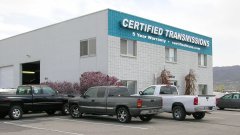-
Posts
644 -
Joined
-
Last visited
-
Days Won
130
Content Type
Forums
AutoShopOwner Articles
Downloads
Blogs
Gallery
Profiles
Events
Store
Links Directory
Shop Labor Rates
Community Map
Everything posted by Transmission Repair
-

What Happened, Joe?
Transmission Repair replied to Transmission Repair's topic in General Automotive Discussion
You're EXACTLY right, sir. Silly me. I had unknowingly toggled fluid view. I toggled it back and everything is back as I like it! Thank you so much for the diagnosis/tip. -

Are Exit Interviews Valuable?
Transmission Repair replied to Joe Marconi's topic in Human Resources, Employees
I rarely did exit interviews. The few times I did conduct an exit interview, I did learn something. Most of the time I either fired somebody or they quit; no exit interview for those ex-employees. I've only regretted somebody leaving our shop 3 times and I still regret those guys to this day. It's an uncomfortable situation for most, me included.- 2 replies
-
- 1
-

-
- exit interviews
- human resource
-
(and 1 more)
Tagged with:
-

Is it Time for Repair Shops to Specialize?
Transmission Repair replied to Joe Marconi's topic in Dealing With Competition
When it comes to "All Makes, All Models" we were already pretty much doing that with transmissions. It's easier to say that because all we did was transmissions. However, there were half-a-dozen or so of certain Euros we would still do although we didn't like the risk level. We just priced those higher, about the price of the dealer, to do those "unfavorite" units. I remember a Porsche Cayenne that had a wiped out transmission and a rear driveline no driveline shop would touch. We had to special order the rear driveline (w/3 U-Joints and a carrier bearing) from the dealer for $1,500, our cost. Long story made short, the total bill ended up being around $9K. If the customer would have given me a price objection, I would have told him to take to whomever you want. I guess the best way I could put it is, "We'll work on any make or model... for a price." -

DVI, A Tool. Not a Sales Person
Transmission Repair replied to Joe Marconi's topic in Workflow, Procedures, Shop Forms
Like Bantar, we've never used a DVI in the transmission business. The only question we have to answer is "Can the transmission be fixed in the vehicle?" Or do we have to pull the transmission out. Either way, it's a pretty basic determination. I don't really see a need for a DVI for transmissions. If we were doing GR, you bet, I'd use a DVI. Just my opinion.- 11 replies
-
- dvi
- digital inspection
- (and 2 more)
-

Auto Makers ask EU to Pause EV Shift!
Transmission Repair replied to Joe Marconi's topic in Automotive News
I feel 100% of new car sales will be EVs eventually, but I'm not sure about the year. UK says 2040. I think ICE vehicles will remain for larger PU trucks and the OTR rigs for quite a while. But, eventually new truck sales will succumb to the same fate as well. IMHO, I think electric is the way to go. Currently, we have 2 Toyota hybrids in our driveway. One is a 2021 Toyota RAV4 Hybrid and the other is a 2006 Toyota Highlander Hybrid. Who knows, they might just be last vehicles we ever own until we pass away. 🙂And if that's the case, it doesn't really matter. 🙂 -
The format of the website changed. There are no longer "sections". Rather, everything is in one big pile you have to scroll through. What's up with that? I would like to think it's one of my settings that I have set incorrectly. Joe, please educate me. J. Larry Bloodworth [email protected] 801-885-2227
-
Larry Bloodworth, wife Lorraine, with Bill Haas at a marketing training seminar in Monterrey, California.
-

Larry & Lorraine with Bill Haas
Transmission Repair posted a gallery image in Trade Shows and Events
-

Certified Transmissions
Images added to a gallery album owned by Transmission Repair in How To Videos
This was our shop before we retired. Although the building looks large, it only had 3K sq. ft. of shop space with only 4 lifts. We were a transmission only shop that also did transfer cases and diffs. We consistently did $1.2M/yr. in sales. We were located in a highly visible location on I-15 in Draper, Utah, a suburb of Salt Lake City. We had a 250K+ daily traffic count. We sold the business in 2015 to a local competitor and sold the real estate in 2020. Shop Video: Shop Photo: I can be reached at: J. Larry Bloodworth / [email protected] / 801-885-2227 -
From the album: Certified Transmissions
-
From the album: Certified Transmissions
-
Have you ever watched a movie for the 2nd time? Is it just me, or has anyone seen stuff the second time around that you didn’t catch in the first viewing? Well, that’s exactly what happened to me with this book, “The Dark Side of Franchising”. This book is the Kindle edition as most of my more recent purchases are. No, I don’t have a Kindle reader. I have the desktop version of the Kindle reader app. It has a feature known as Text-to-Voice that I used the second time. My eyes followed the words as the Kindle app read the book for me. I read this book the second time around in just one 2-hour sitting. It was great.
-
YouTube was founded on Feb. 14, 2005. I’ve been using YouTube to sell work since 2008. Since then, I’ve influenced many people to start selling work that way. The attached video is from an online friend named Rich who works at a Ford dealership. He saw what I was doing and basically copied my sales method. Good for him! I try to keep my videos 3:00 minutes or less. In this example, Rich's video is 7:49 long. To me, that's way too long, but it is what it is.
-
I just finished reading a book entitled "The Dark Side of Franchising: How to Avoid Being Swindled and Make an Educating Investing Decision". The book is a real eye-opener. The author, Robert Edwards, runs a company named Franchise City. They basically advise, consult, and recommend franchises that match the buyer's talents, goals, and exit plans to an appropriate franchisor. His contention is that the franchise industry should be regulated like real estate agents, doctors, and lawyers. I was shocked to learn there is absolutely no regulation in franchise sales. According to the author, the opposite is more true than not. The industry is rife with somewhere between a used car salesman and a con man. There's too much government in our lives and we need less, not more, government. But on the topic of franchising, that should be regulated. Even a barber or anyone who drives a car needs to be licensed. I’ve been recently looking into franchising myself. That’s what prompted me to come into contact with Robert Edwards of Franchise City. Everything that the author said in the book, I personally experienced. I purchased the book on my own with no prompting from the author. If anyone was to consider purchasing a franchise, I would highly recommend this book.
-
It's no secret that inflation is causing the prices to go up on everything. For many shop owners, their first knee-jerk reaction would be to try to reduce expenses. Instead, I want to offer a suggestion that may give you a different perspective on handling runaway inflation. For argument's sake, let's suppose that a shop's costs have gone up 15% from what they used to be. Instead of trimming expenses by 15%, I will offer a different way to do it. I would say raise your prices by 15%, and here's why. In our shop, expenses run 40% of revenue. We did $100K/mo. in total gross sales. Expenses were $40K/mo. 15% of $40,000 in expenses is $6,000. However, 15% of $100,000 in gross sales is $15,000. Going up in price by 15% makes you 2.5 times more than cutting expenses by 15%. I suggest that even during non-inflationary times, it is always more profitable to go up by a percentage than cut your expenses by the same percentage. However, while this might sound easy, it creates another problem. That problem is sales skill and value building. This is why it's so important to get professional sales and telephone training. There's no shortage of professional trainers in our industry. One of the most significant breakthroughs in my professional career is when I quit going to technical seminars and training. Instead, I went to professional sales and telephone training. My life became so much easier, and so can yours by raising the sales price with professional sales, telephone, and marketing training. No increase in price will help if you can't sell it.
-
Location is a huge part of marketing. A business guru once told me, "Expensive rent is the cheapest advertising you can buy." To that end, I wrote an article titled, "How Changing Location, Changed My Life". It's a 1,400-word 7-minute read and chronicles the benefits of doing mindful due diligence in selecting a location. I want to thank Joe Marconi in writing this article. https://docs.google.com/document/d/1NXBSu9a22bCWnQVh6dRM1dMu76gESAr0MImFrjpOtWk/edit?usp=sharing
-

4 Reasons Not To Do Your Own Payroll
Transmission Repair commented on nptrb's blog entry in Three Rivers Bookkeeping Success Guide
I agree a business should not do their own payroll. We used Intuit's payroll service and it was great. We used QuickBooks Desktop Pro. We did, however, calculate our own payroll and print our own checks. Intuit would make our 941 deposits and do our quarterlies by logging into our system and run all the reports. My wife is an accountant and has a degree in economics, so this may not work for everyone, but it worked for us. -
The second video at the bottom of this page will help members to calculate a labor rate. While this was specifically designed for dealerships, a lot of the same principles can be applied to our shops. No need to see what others are charging, we charge off our costs. https://chriscollinsinc.com/training-videos









